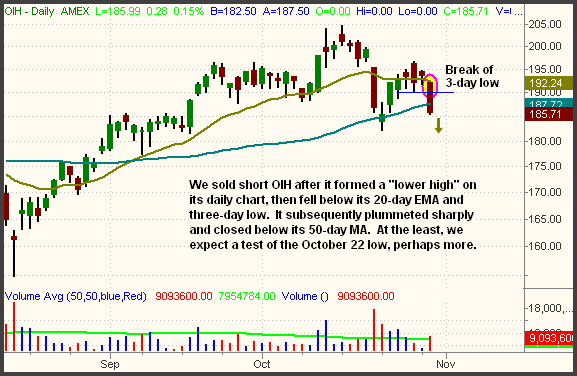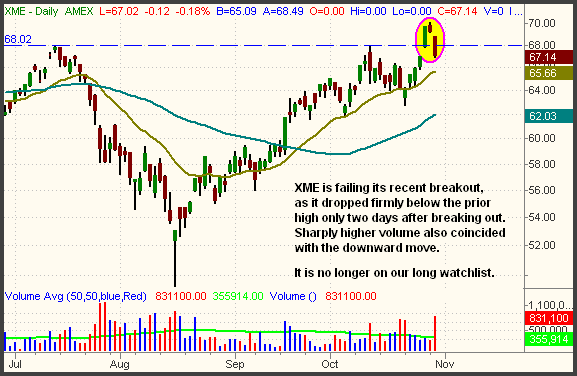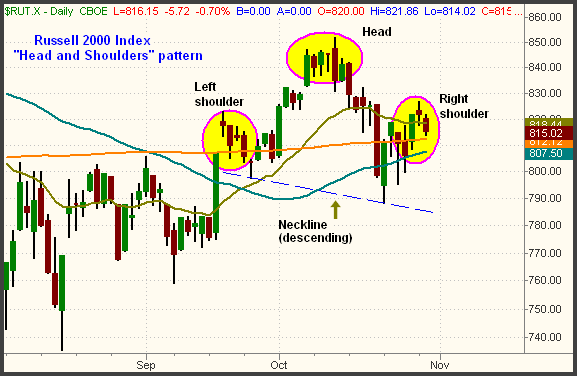|
The Wagner Daily ETF Report for October 31
Much like the previous day, stocks remained in a holding pattern ahead of this afternoon's Fed report on interest rates and economic policy. Just as the major indices finished modestly higher on Monday, they closed lower by an insignificant percentage yesterday. The narrow, sideways trading range of the broad market was also similar to the prior day's price action. Continued leadership in the tech arena enabled the Nasdaq Composite to close unchanged, but the S&P 500, Dow Jones Industrial Average, and S&P Midcap 400 indices each lost 0.6%. The small-cap Russell 2000 was lower by 0.7%. Selling pressure in the final thirty minutes of trading caused all of the main stock market indexes except the Nasdaq to finish near their intraday lows. Both the Nasdaq Composite and Nasdaq 100 indexes settled in the middle of their respective trading ranges.
Total volume in the NYSE was on par with the previous day's level, while volume in the Nasdaq was just 5% higher. The unchanged volume in the NYSE prevented the index from registering another bearish "distribution day" that would have pointed to institutional selling. The modest increase in Nasdaq turnover was basically inconsequential because the index was flat. Despite the seven-day uptrend in the broad market, don't forget that both the S&P and Nasdaq are still showing five days of institutional selling within recent weeks. This means the overall intermediate-term balance of power remains with the bears, but the distribution has certainly been more pronounced in the S&P and Dow than the relatively strong Nasdaq. A confirmed surge to new highs in those indexes would wipe out the negative effect of the recent "distribution days."
In mid-October, the Oil Service HOLDR (OIH) failed its breakout to a new high, then promptly reversed sharply lower on October 19. When it broke support of its primary uptrend line and 20-day EMA that day, we initiated a short sale around the $192 area. One day later, we covered OIH for an 8-point gain because it had already fallen to our downside profit target. Expecting just a feeble retracement before making another leg lower, we re-entered the short position on October 23, as it bounced into resistance of its 20-MA on the hourly chart. The bad news is that our re-entry attempt was too early and we stopped out for nearly a 6-point loss. The good news, however, is that we managed risk and protected profit by only re-entering the position with half of our original share size. This enabled us to hold on to a majority of our gains from the first short sale, despite the loss on the re-entry.
Yesterday, OIH finally began to head back down towards its October low in a big way. Tumbling 4.1% yesterday, OIH was one of the biggest losers of the nearly 600 ETFs we monitor daily. Fortunately, we spotted the relative weakness early in the session and sold short OIH when it broke support of its 20-day EMA and three-day low. Our new short entry is annotated on the daily chart of OIH below:

From our short sale at $190.41 to yesterday's close of $185.71, the trade is currently showing an unrealized gain of 4.7 points. This time, we also entered with full share size instead of the half position of our October 23 re-entry attempt. At a minimum, we expect OIH to test support of its October low, at the $182 - $182.50 area. But with the formation of a "lower high" on the daily chart that followed a failed breakout to a new high, downside momentum may be strong enough to cause OIH to make another leg lower. As always, we will use a trailing stop to protect the gain while maximizing profit.
Due to a rally into resistance of its prior high, we sold half of our long position in the U.S. Natural Gas Fund (UNG) into strength yesterday, locking in a gain of 6.9% on the one-week hold. We're using support of the hourly uptrend line, beginning with the October 23 low, to continue trailing a stop higher on the remaining shares. If it rallies above its prior high from October 18, we may re-enter the shares of the half position we sold yesterday.
The iShares 20+ year Treasury Bond Fund (TLT), along with most other fixed-income ETFs, continues to consolidate near its recent high. The pattern is bullish and it looks as though the bond ETFs will make another leg higher. However, we scratched our long position in TLT yesterday because we did not want to hold such an interest-rate sensitive equity through to day's Fed announcement. If TLT breaks out above its range after the 2:15 pm ET decision on interest rates, we may re-enter it, but holding through today's report could be too volatile.
In the October 29 issue of The Wagner Daily, we said we were looking for a pullback entry in both the PowerShares Clean Energy (PBW) and the S&P Metals and Mining SPDR (XME). PBW pulled back to just above its breakout level yesterday, and also held above the prior day's low. Assuming the market doesn't sell-off after the Fed announcement, we may buy PBW. XME, however, appears to be failing its breakout and is no longer a good play. On the daily chart below, notice how XME closed firmly below what should have been support of its prior highs:

Two days ago, the breakout looked good, but negative earnings reports from several key companies in the sector have caused the bullish sentiment to change. Though it could stabilize around here and attempt to move back above its pivot, we don't like the severity of yesterday's drop, which also occurred on sharply higher volume. As such, all bets are off for a long entry in XME. Patience to wait for pullbacks and assess subsequent price action, rather than chasing breakouts, frequently enables one to dodge potential losses.
We won't even hazard a guess as to the market's reaction after this afternoon's Fed report. There's a lot of speculation on both sides, so it could become pretty volatile. If the market's reaction is favorable, expect the tech-related sectors to lead the way higher again. But if stocks show weakness after the Fed, consider short sales in the S&P Midcap 400 or Russell 2000 ETFs. Each index is forming the right shoulder of a bearish "head and shoulders" pattern. The Russell 2000 is the weaker of the two indexes because it has a descending neckline, illustrated below:

We're already short the Russell 2000 through being long the inversely correlated UltraShort Russell 2000 ProShares (TWM). The position is currently showing a loss, but that will change quickly if the Russell 2000 moves down to test its neckline. Notice how the index is also about to break below both its 50- and 200-day moving averages again. If it does, downside momentum could rapidly intensify. Conversely, a rally above the high of the right shoulder would invalidate the pattern for the time being.
Open ETF positions:
Long - TWM, UNG (half position)
Short - OIH
Deron Wagner is the Founder and Head Trader of both Morpheus Capital LP, a U.S. hedge fund, and Morpheus Trading Group, a trader education firm launched in 2001 that provides daily technical analysis of the leading ETFs and stocks. For a free trial to the full version of The Wagner Daily or to learn about Wagner's other services, visit MorpheusTrading.com or send an e-mail to deron@morpheustrading.com.
|